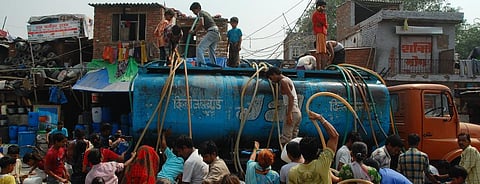COVID-19 outbreak: More hand washing can increase India's water woes
Experts maintain that washing hands with soap and water is one of the best possible ways to remove the novel coronavirus (SARS-CoV-2) and in turn, keep a check on the global disease outbreak (COVID-19).
In India, however, it is a near-impossible task for the homeless and the thousands of urban poor who live in slums across major cities and towns, to maintain good hygiene.
Refilling water containers in households without access to piped water and securing soap for hand washing requires constant user effort and expense.
This creates a barrier against proper hand washing, something the World Health Organization (WHO) recommends is the easiest and best way to prevent transmission of the virus, in addition to social distancing.
A proper hand wash involves lathering soap and scrubbing hands on both sides for at least 20 seconds, according to WHO guidelines.
A 30 to 40 second hand wash would use up around four litres of water if the tap is on, or two litres with the tap closed, while scrubbing with soap.
Around 20 to 40 litres of water is used up every day, with the assumption that every person cleans her hands at least 10 times a day, instead of a usual average of five times a day.
A family of five members would thus need 100 to 200 litres of water per day only to wash hands.
This would result in the generation of around 200 litres of wastewater per day, a 20 to 25 per cent increase in water demand and generation of wastewater from human settlements.
Estimated water usage in five-person household
|
Period of Time |
Water used every 20 seconds (in litres) |
Water wasted (while scrubbing soap) every 15 seconds (in litres) |
Wastewater generated (in litres) |
|
Daily per household (5 persons) |
100 |
150 |
225 |
|
Monthly per household (5 persons) |
3100 |
4650 |
6975 |
Note: Water use calculation based on two litres per person and 10 hand washes per day and 4 litres per person with the tap running while applying soap on hands.
The calculation of wastewater generation is based on 90 per cent of water used, including the volume wasted when taps are on while scrubbing soap.
The additional water requirement — including treatment of wastewater — has huge implications for India, with approximately 160 million of India’s 1.3 billion population without access to clean water.
The remainder already struggle to get their water demands met. A supply gap and the current 65 per cent untreated wastewater already causes major health risks.
This increase in demand will result in immense pressure on overstretched water utilities — including jal boards, jal nigams and public health engineering departments — that struggle to meet current water supply gaps.
This will further exploit groundwater and increase the volume of untreated wastewater.
This situation will be further aggravated in summer, when water supply sources will run dry.
The cities of Chennai and Shimla, for example, are projected to slide to Day Zero. Questions will be raised as to where these cities — and many others — will get additional water to support an increase in hand washing for curbing transmission of the virus.
A major emphasis should be on reducing the amount of water that comes of a tap out per minute. Good hygiene and water saving needs to go hand-in-hand.
A need to spread awareness to be water-efficient by closing taps or using taps with sensors that automatically switch off when one’s hands are not under the tap, during the process of scrubbing soap.


